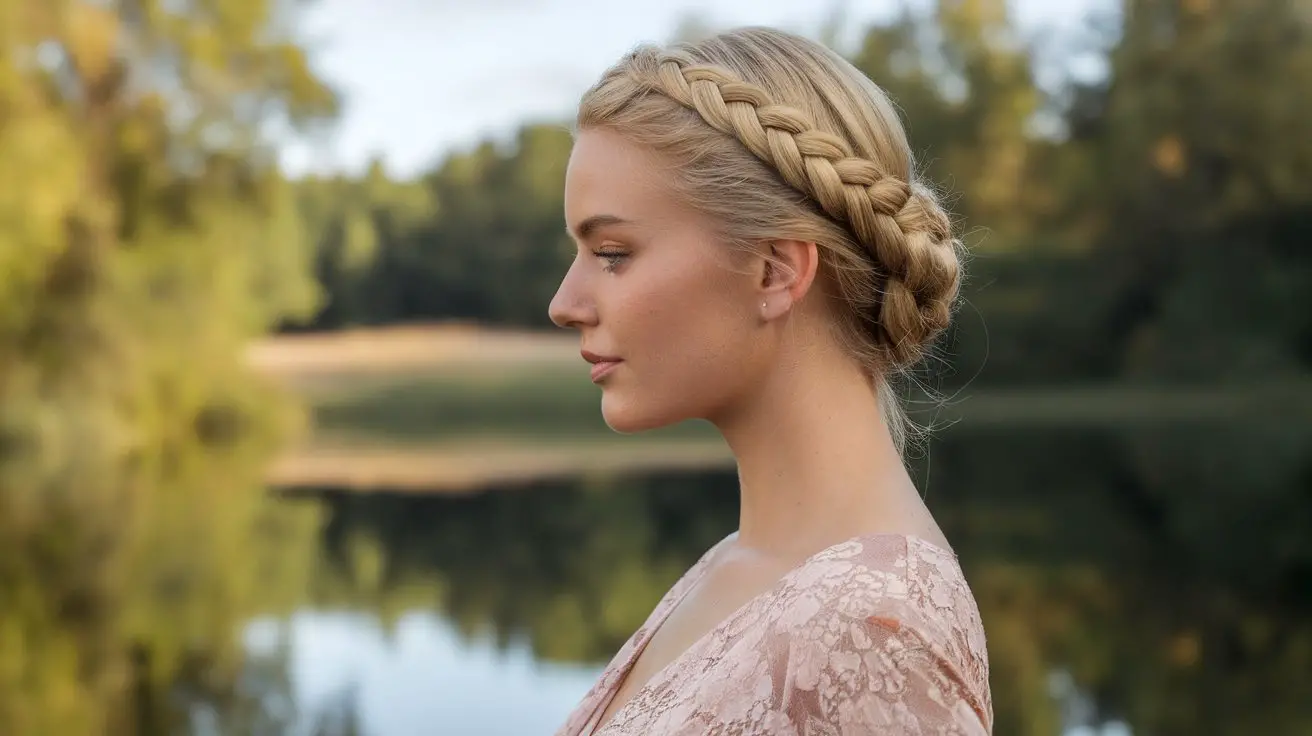The Dutch crown braid stands as a timeless hairstyle that continues to captivate women across generations. This elegant and intricate look combines the classic appeal of braids with a regal touch, creating a hairstyle that’s both sophisticated and versatile. From casual outings to formal events, the Dutch crown braid offers a perfect blend of style and practicality.
Modern women are drawn to this hairstyle for its ability to suit various occasions and complement different face shapes. The Dutch crown braid’s popularity stems from its adaptability – it can be worn sleek and polished for a professional setting or loosened for a more relaxed, bohemian vibe. Its enduring charm lies in its ability to make women feel confident and put-together, regardless of the event or season.
The Dutch crown braid boasts a rich history, tracing its roots back to ancient civilizations where braids symbolized status and cultural identity. Over time, this hairstyle evolved, becoming a staple in European fashion and eventually spreading worldwide. In the following sections, we’ll explore the step-by-step process of creating a Dutch crown braid, discuss styling tips for different hair types, and share maintenance advice to keep your braid looking flawless throughout the day. Continue reading to master this elegant hairstyle and add a touch of regality to your look.
What Makes the Dutch Crown Braid Unique?
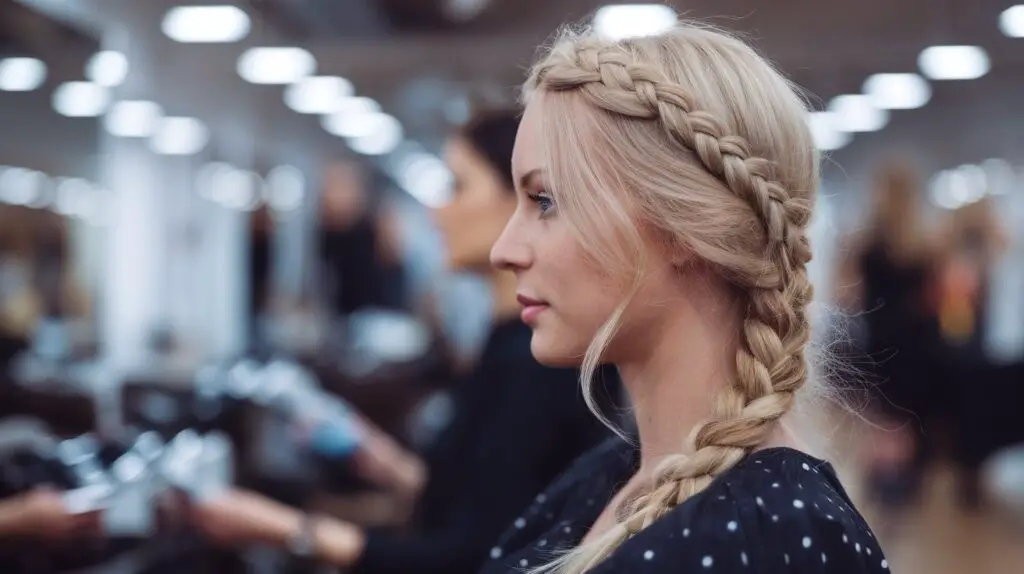
The Dutch crown braid stands out as a hairstyle that combines elegance with practicality. This braiding technique creates a stunning look that encircles the head like a crown, offering a regal appearance suitable for various occasions.
Explanation of the Dutch braiding technique
The Dutch braid, also known as an inverted or reverse French braid, is created by crossing the hair strands under each other instead of over. This technique results in a braid that sits on top of the hair rather than being tucked in, giving it a raised, three-dimensional appearance.
To create a Dutch braid, you start by dividing the hair into three sections at the crown of the head. As you braid, you incorporate additional hair from the sides into each section before crossing it under the middle strand. This process continues around the head, forming a beautiful crown-like pattern.
Why is this technique so popular? The answer lies in its visual appeal and staying power. The Dutch braiding method creates a more defined and prominent braid that tends to hold its shape better throughout the day.
Differences between Dutch and French braids
While Dutch and French braids may look similar at first glance, there are key differences that set them apart:
- Direction of weaving: Dutch braids cross under, French braids cross over
- Appearance: Dutch braids sit on top of the hair, French braids are more flat
- Texture: Dutch braids have a more textured, rope-like look
- Visibility: Dutch braids show more detail and dimension
These differences allow for unique styling options and effects, making the Dutch braid a versatile choice for those seeking a distinctive look.
Benefits of choosing a Dutch crown braid
Opting for a Dutch crown braid offers several advantages. This hairstyle provides excellent heat-free styling, perfect for protecting your hair from damage caused by hot tools. It’s also a great option for second or third-day hair, as the texture can help disguise any oiliness.
Additionally, the Dutch crown braid offers a secure style that stays in place during physical activities. Whether you’re hitting the gym or attending an outdoor event, this braid will keep your hair neat and out of your face.
Versatility in styling with a Dutch crown braid
One of the most appealing aspects of the Dutch crown braid is its versatility. You can customize this style to suit your preferences and the occasion. For a more formal look, keep the braid tight and sleek. Want a more relaxed, bohemian vibe? Gently pull at the braid to loosen it and create a softer appearance.
You can also incorporate accessories like flowers, ribbons, or decorative pins to add a personal touch to your Dutch crown braid. This adaptability makes it a go-to style for everything from casual outings to weddings and special events.
Suitability for different hair types and lengths
The Dutch crown braid works well with various hair types and lengths. For those with shorter hair, you can create a partial crown braid or incorporate extensions for a full crown effect. Women with longer hair can achieve a full crown braid with ease.
Curly and textured hair types can benefit from the Dutch braiding technique as it helps to control frizz and define natural texture. For those with fine or straight hair, the raised nature of the Dutch braid can create the illusion of more volume and thickness.
Regardless of your hair type, using a texturizing spray or dry shampoo before braiding can help add grip and make the process easier. This is especially helpful if you have very smooth or slippery hair.
The Dutch crown braid’s ability to work with different hair types and lengths makes it an inclusive style that many women can enjoy. Its adaptability to various textures and lengths allows for personalized styling options, ensuring that each woman can create a look that suits her individual needs and preferences.
How to Master the Dutch Crown Braid
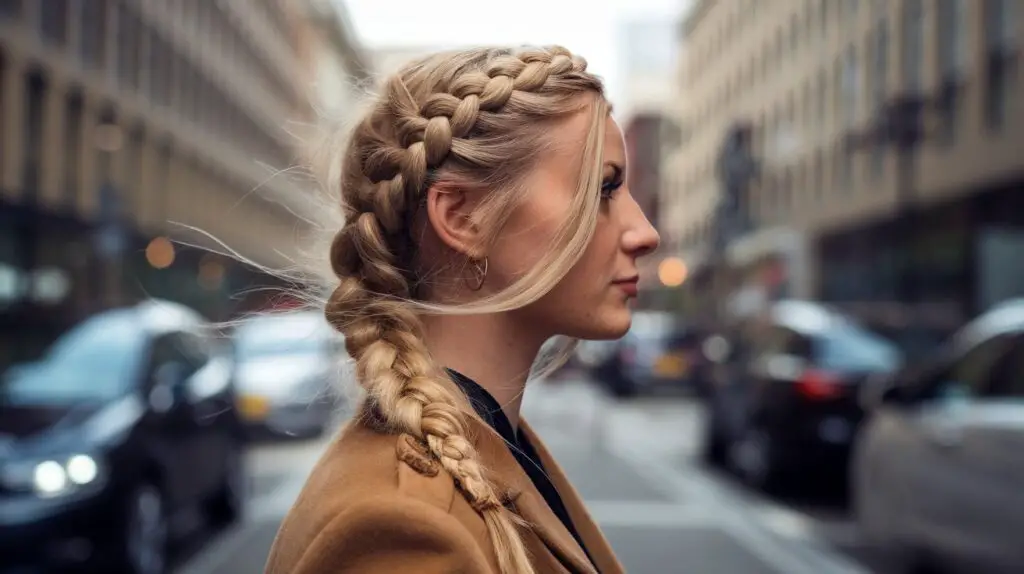
Creating a Dutch crown braid might seem challenging at first, but with practice and the right approach, you can master this elegant hairstyle. Let’s explore the process and provide you with helpful tips to achieve a stunning result.
Essential tools and products needed
Before you start braiding, gather the necessary items. You’ll need a wide-toothed comb to detangle your hair, a fine-toothed comb for parting, and several hair ties. Bobby pins are crucial for securing loose ends and stray hairs. A texturizing spray or dry shampoo can add grip to slippery hair, making it easier to braid.
For those with fine or thin hair, a volumizing mousse applied to damp hair before styling can create more fullness. If you have thick or coarse hair, a leave-in conditioner can help smooth the strands and make them more manageable.
Step-by-step guide to creating a Dutch crown braid
Now that you have your tools ready, let’s go through the process:
- Start with detangled hair. Brush out any knots to create a smooth base for braiding.
- Part your hair down the middle, from forehead to nape.
- Begin on one side, taking a section of hair near your forehead.
- Divide this section into three equal strands.
- Start the Dutch braid by crossing the right strand under the middle, then the left strand under the new middle.
- As you continue braiding, incorporate new hair from the scalp into each section before crossing it under.
- Follow the hairline, braiding around your head.
- Once you reach the nape of your neck, continue braiding the remaining hair without adding new sections.
- Secure the end with a small elastic.
- Repeat the process on the other side of your head.
- Once both braids are complete, wrap them around your head, tucking the ends underneath and securing with bobby pins.
Tips for beginners to perfect their technique
Mastering this hairstyle takes time and practice. Here are some tips to help you improve:
- Start with damp hair for better control
- Use a mirror to see the back of your head
- Practice regular Dutch braids before attempting the crown
- Keep the tension consistent for a neat appearance
- Take small sections of hair to add for a more intricate look
Remember, patience is key. Don’t get discouraged if your first attempts don’t turn out perfectly. With regular practice, you’ll see improvement in your braiding skills.
Common mistakes to avoid while braiding
As you work on perfecting your Dutch crown braid, be aware of these common pitfalls:
Inconsistent tension: Maintaining even tension throughout the braid is crucial for a polished look. If some sections are tighter than others, your braid may appear uneven.
Neglecting to smooth as you go: Take a moment to smooth each section before incorporating it into the braid. This helps prevent bumps and flyaways.
Braiding too loosely: While a relaxed braid can look beautiful, braiding too loosely may cause your style to unravel quickly.
Rushing the process: Take your time, especially when starting out. Rushing can lead to mistakes and a messy final result.
Not securing properly: Failing to anchor your braid securely can cause it to come undone throughout the day.
How to secure and finish the braid for a polished look
The final steps are crucial for a long-lasting, polished Dutch crown braid. Once you’ve completed both braids and wrapped them around your head, use bobby pins to secure them in place. Insert the pins at an angle, catching both the braid and the underlying hair for maximum hold.
To deal with any flyaways, lightly mist a small brush with hairspray and gently smooth down any stray hairs. For a softer, more romantic look, carefully pull at the edges of the braid to loosen it slightly.
If you have shorter layers that don’t reach the braid, secure them with crossed bobby pins. You can also incorporate these shorter pieces into your look by leaving them out to frame your face.
Finish with a light mist of flexible-hold hairspray to keep everything in place without making your hair stiff or crunchy. This will help your Dutch crown braid last throughout the day or evening.
With these steps and tips, you’re well on your way to creating beautiful Dutch crown braids. As with any new skill, the key is practice. Each time you create this hairstyle, you’ll find it becomes easier and your results more polished. Soon, you’ll be able to craft this elegant look with confidence and ease.
Styling Ideas with a Dutch Crown Braid
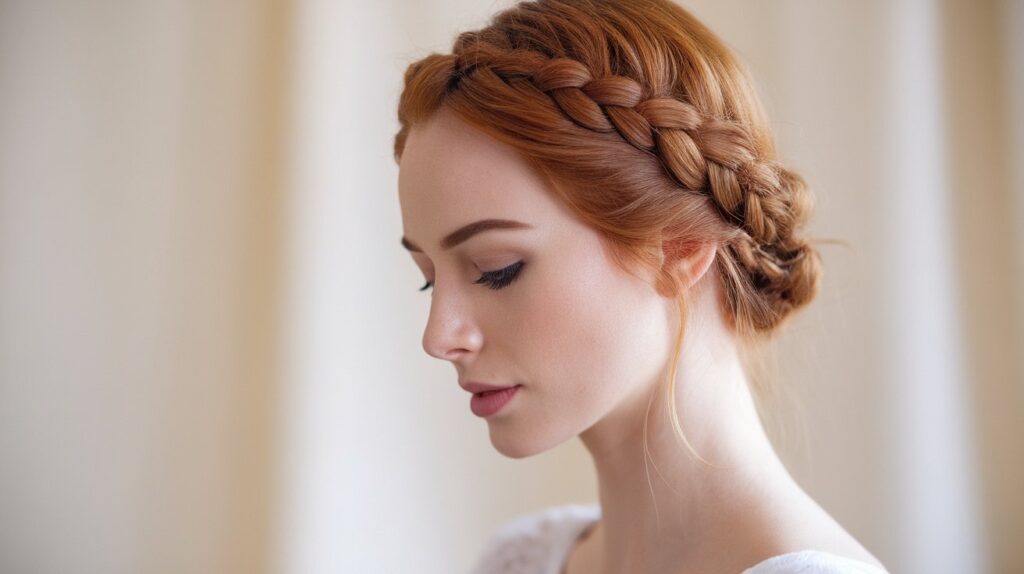
The Dutch crown braid offers a world of styling possibilities, from casual everyday looks to elegant formal styles. Let’s explore various ways to wear this versatile hairstyle and make it your own.
Casual day looks with a Dutch crown braid
For a relaxed, everyday appearance, try a loose Dutch crown braid. Start by creating the braid with less tension, allowing some strands to fall naturally around your face. This softens the look and gives a more laid-back vibe. Pair this style with your favorite jeans and a comfy sweater for a chic, effortless outfit.
Another option for casual wear is the half-crown braid. Begin the Dutch braid at one temple, continuing it around the back of your head, and secure it behind the opposite ear. Leave the rest of your hair loose for a playful, bohemian-inspired look.
Elegant updos incorporating the Dutch crown braid
Want to elevate your style for a more sophisticated event? Transform your Dutch crown braid into an elegant updo. One approach is to create a full crown braid and then twist the remaining hair into a low chignon. Secure it with bobby pins and add some decorative hair accessories for extra glamour.
For a romantic look, try the braided bun. After completing your Dutch crown braid, gather all your hair, including the braid, into a high bun. This creates a regal appearance perfect for weddings or formal dinners.
You can also experiment with a half-up, half-down style. Braid the top section of your hair into a Dutch crown, leaving the lower half loose. Curl the loose hair for added volume and sophistication.
Creative variations like double or side braids
Why not try a double Dutch crown braid for a more intricate look? Start by parting your hair down the middle and creating two separate Dutch braids on each side of your head. Wrap them around to meet at the back, pinning them in place.
For an asymmetrical style, consider a side Dutch crown braid. Begin the braid on one side of your head and continue it diagonally across to the opposite side. This creates an interesting, eye-catching style that’s sure to turn heads.
Here are some other creative variations to experiment with:
- Fishtail Dutch crown braid
- Ribbon-woven Dutch crown braid
- Braided headband with loose waves
- Flower-adorned Dutch crown braid
Seasonal trends featuring the Dutch crown braid this year
This year’s trends showcase the Dutch crown braid in various forms. For spring and summer, loose, nature-inspired braids are popular. These are often adorned with small, delicate flowers or leaves for a fresh, organic look.
As we move into fall and winter, tighter, more polished Dutch crown braids take center stage. These are frequently paired with warm-toned hair accessories like gold leaf hair clips or burgundy velvet headbands.
Festival season brings colorful Dutch crown braids to the forefront. Temporary hair chalk or clip-in colored extensions can be woven into the braid for a fun, vibrant appearance that matches the festive atmosphere.
Adapting the style for formal occasions
The Dutch crown braid can be easily adapted for formal events. For a black-tie gala, consider a sleek, tight braid paired with statement earrings. This creates a clean, sophisticated look that complements an elaborate outfit without overshadowing it.
For prom or homecoming, try a Dutch crown braid that transitions into cascading curls. This romantic style combines the structure of the braid with the softness of loose curls, creating a perfect balance for these special occasions.
Wedding hairstyles often feature Dutch crown braids. Brides might opt for a delicate version as a base for a veil or tiara. Bridesmaids could choose a fuller Dutch crown braid adorned with flowers that match the wedding’s color scheme.
The key to adapting this style for formal occasions is precision. Take your time to create a neat, even braid, and use plenty of bobby pins and hairspray to keep everything in place throughout the event.
Whether you’re heading to the office, attending a wedding, or just enjoying a day out, there’s a way to style the Dutch crown braid to suit your needs. Don’t hesitate to experiment with different variations and accessories to find the look that best expresses your personal style. With practice, you’ll discover countless ways to make this versatile hairstyle your own.
Maintaining Your Dutch Crown Braid
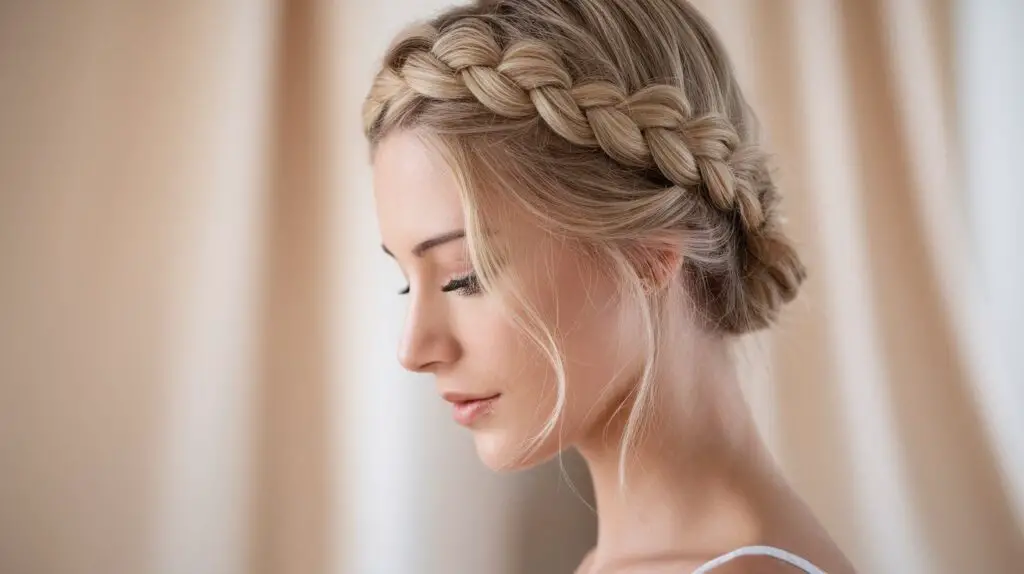
Keeping your Dutch crown braid looking fresh and polished throughout the day can be a challenge. However, with the right techniques and products, you can maintain its beauty from morning till night. Let’s explore some effective ways to care for your braided hairstyle.
Daily care tips to keep your braid looking fresh
Start your day by gently misting your braid with a light hold hairspray. This helps to set the style and control flyaways without making your hair stiff or crunchy. Throughout the day, avoid touching your braid too much, as the oils from your hands can make it look greasy.
If you notice any loose strands, use bobby pins that match your hair color to tuck them back into the braid. For a quick touch-up, run a small brush or comb over the surface of the braid to smooth any frizz.
At night, protect your braid by sleeping on a silk or satin pillowcase. This reduces friction and helps prevent frizz and tangles.
Recommended products for maintaining hold and texture
The right products can make a significant difference in how long your Dutch crown braid lasts. Here are some essential items to consider:
- Texturizing spray: Adds grip and volume to your hair before braiding
- Dry shampoo: Absorbs excess oil and refreshes your scalp
- Flexible hold hairspray: Keeps your braid in place without stiffness
- Anti-frizz serum: Smooths flyaways and adds shine
When choosing products, opt for those that are lightweight and won’t weigh down your braid. Heavy creams or oils can make your hair look greasy and cause the braid to lose its shape faster.
How to transition from day to night with a Dutch crown braid
Your Dutch crown braid can easily transition from a daytime look to an evening style with a few simple adjustments. For a more formal evening appearance, try adding some sparkle with decorative pins or a delicate headband. You can also gently loosen the braid for a softer, more romantic look.
If you’re heading out after work, consider incorporating some loose curls into the style. Use a curling iron on any hair that’s not part of the braid, creating soft waves that frame your face. This adds volume and glamour to your look without having to start from scratch.
Refreshing your braid without starting over
Sometimes your braid might need a pick-me-up midday. Here’s a quick method to refresh it:
- Spray dry shampoo at the roots to absorb any excess oil.
- Gently massage the dry shampoo into your scalp.
- Use your fingers to lightly fluff the braid, giving it more volume.
- Smooth any flyaways with a small amount of anti-frizz serum.
- Finish with a light mist of flexible hold hairspray.
This process takes just a few minutes and can revive your braid without the need to completely redo it.
Long-term hair care tips for frequent braiders
While Dutch crown braids are beautiful, wearing them too often can stress your hair. To keep your locks healthy, alternate your braided styles with looser hairstyles. This gives your hair a break and helps prevent breakage.
Deep condition your hair weekly to maintain its moisture and strength. Look for treatments that contain proteins and natural oils to nourish your strands.
Be gentle when removing your braid. Use your fingers to carefully unravel it, starting from the bottom and working your way up. Avoid pulling or tugging, which can cause damage to your hair.
Regularly trim your ends to prevent split ends from traveling up the hair shaft. This is especially important if you braid your hair frequently, as the ends can become more prone to damage.
Lastly, stay hydrated and maintain a balanced diet rich in vitamins and minerals. Healthy hair starts from within, so nourishing your body will reflect in the strength and shine of your locks.
By following these tips, you can enjoy beautiful Dutch crown braids while keeping your hair healthy and strong. With proper care and maintenance, your braided styles will look fresh and polished all day long.
The Timeless Appeal of the Dutch Crown Braid
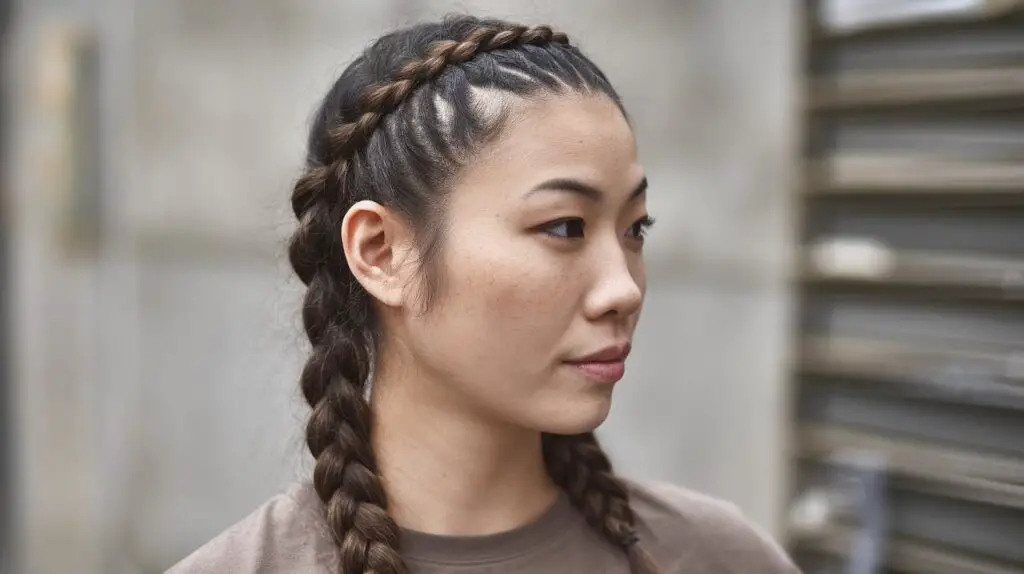
The Dutch crown braid has stood the test of time, gracing the heads of women for generations. This elegant hairstyle continues to captivate with its regal appearance and practical benefits. Let’s explore why this braided look remains a favorite among women of all ages.
Why the Dutch crown braid remains popular through the ages
The enduring appeal of this hairstyle lies in its versatility and timeless beauty. You can wear it to a formal event or a casual outing, making it suitable for various occasions. Its ability to keep hair neat and out of the face while still looking sophisticated is a key factor in its lasting popularity.
Moreover, the Dutch crown braid offers a solution for different hair types and lengths. Whether you have long, short, curly, or straight hair, you can adapt this style to suit your needs. This adaptability has contributed to its widespread appeal across cultures and generations.
Testimonials from women who love this hairstyle
Many women have shared their love for the Dutch crown braid. Sarah, a 28-year-old teacher, says, “I love how this hairstyle keeps my hair in place all day. It’s perfect for busy days at school.”
Another fan, Maria, a 35-year-old executive, shares, “The Dutch crown braid makes me feel put-together and professional. It’s my go-to style for important meetings.”
Even younger women appreciate this classic look. Sixteen-year-old student Emma notes, “I learned how to do this braid from social media. It’s so pretty and makes me feel like a princess!”
The role of social media in popularizing the style today
Social media platforms have played a significant role in reviving interest in the Dutch crown braid. Platforms like Instagram, Pinterest, and TikTok are filled with tutorials and inspiration for this hairstyle. Influencers and celebrities often showcase their own versions, inspiring their followers to try it themselves.
The visual nature of these platforms allows for easy sharing of step-by-step guides, making the technique more accessible to a wider audience. Hashtags like #DutchCrownBraid and #BraidedHairstyles have millions of posts, demonstrating the style’s popularity in the digital age.
How the Dutch crown braid complements modern fashion trends
This classic hairstyle pairs well with contemporary fashion trends. Its versatility allows it to complement various styles, from bohemian chic to sleek minimalism. The braid adds a touch of sophistication to casual outfits and enhances the elegance of formal wear.
Fashion designers often incorporate this hairstyle in their runway shows, showcasing how it can elevate different looks. The Dutch crown braid’s ability to frame the face and highlight facial features makes it a favorite for both everyday wear and special occasions.
Encouragement for readers to try this regal hairstyle themselves
If you haven’t tried the Dutch crown braid yet, now is the perfect time to give it a go. Don’t be intimidated by its intricate appearance – with practice, you can master this technique. Start by watching online tutorials and practicing on a friend or family member before attempting it on yourself.
Remember, the key to a successful Dutch crown braid is patience and persistence. Your first attempts may not be perfect, but each try will improve your skill. Experiment with different variations to find the style that best suits your face shape and hair type.
To help you get started, here are some tips for creating your first Dutch crown braid:
- Begin with slightly damp hair for better control
- Use a texturizing spray to add grip to slippery hair
- Take your time and keep the tension consistent
- Secure loose ends with bobby pins that match your hair color
- Finish with a light-hold hairspray to keep everything in place
The Dutch crown braid offers a beautiful way to style your hair that’s both practical and elegant. Its timeless appeal, combined with its adaptability to modern trends, ensures that this hairstyle will continue to be a favorite for years to come. So why not give it a try? You might just discover your new favorite hairstyle.
Crowning Glory: Embracing the Timeless Elegance of Dutch Braids
The Dutch crown braid stands as a testament to the enduring appeal of classic hairstyles. Its versatility allows it to adapt to various occasions, from casual outings to formal events, making it a go-to choice for women of all ages. The intricate weaving technique not only creates a visually stunning look but also offers practical benefits, keeping hair neat and manageable throughout the day. As social media continues to showcase this style, more women are discovering its charm and learning to create their own variations.
Whether you’re a seasoned braider or new to the technique, the Dutch crown braid offers a world of possibilities for expressing your personal style. Its ability to complement modern fashion trends while maintaining a timeless elegance makes it a valuable addition to any woman’s hairstyling repertoire. By mastering this regal hairstyle, you open the door to countless creative options, allowing you to feel confident and put-together for any occasion. So why not give it a try? Your perfect Dutch crown braid awaits, ready to add a touch of sophistication to your everyday look.
Frequently Asked Questions
Q: What is a Dutch crown braid?
A: A Dutch crown braid is a hairstyle where the hair is braided around the head in a crown-like pattern, with strands crossed under each other instead of over.
Q: How is a Dutch braid different from a French braid?
A: Dutch braids cross hair strands under each other, while French braids cross strands over. This creates a raised, more visible braid in the Dutch style.
Q: Can you do a Dutch crown braid on short hair?
A: Yes, you can create a partial Dutch crown braid on shorter hair or use extensions to achieve a full crown look.
Q: What products help maintain a Dutch crown braid?
A: Texturizing spray, dry shampoo, flexible hold hairspray, and anti-frizz serum are helpful for maintaining a Dutch crown braid.
Q: How long does a Dutch crown braid typically last?
A: With proper care, a Dutch crown braid can last 1-3 days, depending on your hair type and daily activities.
Q: Is the Dutch crown braid suitable for formal occasions?
A: Yes, the Dutch crown braid can be styled elegantly for formal events, making it a versatile choice for various occasions.
Q: How can I learn to do a Dutch crown braid?
A: You can learn through online tutorials on platforms like YouTube, Instagram, or TikTok, or by practicing on a friend before attempting it on yourself.
Q: What are some ways to customize a Dutch crown braid?
A: You can customize your Dutch crown braid by adding accessories like flowers or ribbons, varying the tightness of the braid, or incorporating different braiding techniques.

